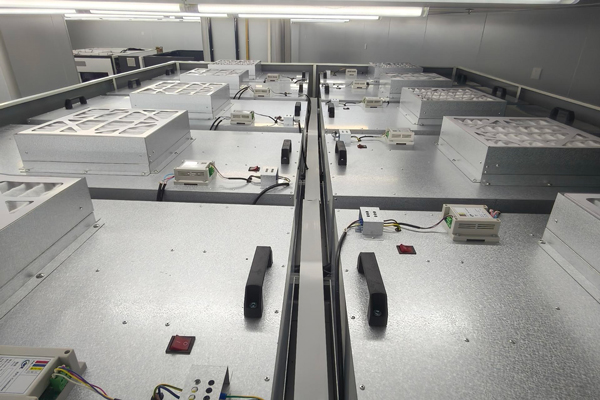As cleanroom technology continues to evolve, more industries—such as pharmaceuticals, optics, electronics, and biotechnology—require not only strict cleanliness but also precise control over temperature and humidity. Recently, while working with a client at Dersion, we encountered a project that emphasized the critical need for consistent environmental conditions to protect product performance. In response, we explored how to design a modular cleanroom that meets the dual challenge of temperature and humidity control.
Below is a detailed guide on how to approach the design and implementation of a modular cleanroom with constant temperature and humidity control.
1. Clarify Requirements and Establish Performance Standards
The first step is to clearly define the cleanroom’s required parameters:
- Cleanliness level (e.g., ISO Class 7 or ISO Class 5 as per ISO 14644)
- Temperature range (e.g., 21 ± 1°C)
- Humidity range (e.g., 50 ± 5% RH)
- Air change rate and pressure differentials
You must assess internal heat and moisture loads, which include:
- Personnel load – number of operators and their activity levels
- Equipment load – heat and humidity generated by machinery
- Fresh air load – outdoor air that needs conditioning
These factors help calculate required cooling, heating, humidification, and dehumidification capacities to maintain stable environmental conditions.
2. Designing Optimal Airflow Patterns
Airflow is a critical component in regulating temperature, humidity, and cleanliness.
- Unidirectional (Laminar) Flow: Modular cleanrooms designed for high precision commonly use unidirectional airflow from ceiling to floor. FFUs (Fan Filter Units) are mounted on the ceiling to supply filtered air directly downwards, while return air grilles are installed near the floor level to guide airflow smoothly out of the clean zone. This setup prevents turbulence and dead zones, reducing contamination risk and supporting uniform environmental control.
- Positive Pressure: Maintain a pressure differential of 5–15 Pa between the cleanroom and adjacent areas. This prevents unfiltered air from infiltrating the space, which can introduce both particulate contamination and temperature/humidity fluctuations.
3. Configuring the HVAC and Dehumidification Systems
A robust HVAC system is the backbone of any cleanroom with tight environmental controls. The selection of system components should balance energy efficiency with control accuracy.
- Chillers & Air Conditioners: Use variable-frequency drive (VFD) chillers or direct expansion (DX) air conditioners combined with electric heating coils for responsive and stable temperature control.
- Humidity Control Systems:
- Humidification: For environments that need precise moisture addition, consider electrode humidifiers (simple and effective) or ultrasonic humidifiers (preferred for ultra-precise or static-sensitive industries).
- Dehumidification:
- Use rotary wheel dehumidifiers for ultra-low dew point applications such as semiconductor or lithium battery production.
- Use refrigeration-based dehumidifiers for general applications where moderate dehumidification is needed.
- Fresh Air Treatment (MAU): Incorporate a Make-Up Air Unit (MAU) that pre-treats fresh air by pre-cooling, pre-heating, and filtering. This reduces the load on the main HVAC system and improves consistency in the cleanroom’s internal environment.
4. Developing an Intelligent Control System
Once mechanical systems are in place, intelligent automation ensures long-term reliability and efficiency.
- Sensor Deployment: Install high-precision sensors for temperature and humidity in both critical process areas and return air ducts. These provide real-time data on environmental fluctuations.
- PLC-Based Control: A Programmable Logic Controller (PLC) can manage HVAC and humidification/dehumidification systems. It automatically adjusts parameters such as airflow speed, temperature setpoints, and humidity levels based on sensor data. If abnormalities occur, the PLC can issue alerts, trigger safety protocols, or switch to backup systems.
- User Interface & Monitoring: Use a digital control panel or a Building Management System (BMS) that offers:
- Real-time monitoring
- Remote control capabilities
- Historical data logging for traceability and compliance audits
- Alarm notifications for deviations in environmental conditions
5. Modular Advantages for Constant Environment Control
Modular cleanrooms offer unique benefits when implementing constant temperature and humidity control:
- Factory-prefabricated components ensure uniform construction quality.
- Short installation time reduces exposure to site-based uncertainties.
- Flexible configuration allows you to expand, relocate, or reconfigure cleanroom modules without major disruption.
- Scalability makes it easier to apply identical temperature and humidity systems across multiple locations or for future expansions.
Conclusion
Designing a modular cleanroom with constant temperature and humidity requires careful planning, precise load calculations, airflow optimization, a well-configured HVAC system, and an intelligent control system. With these elements in place, you can create a highly stable, energy-efficient cleanroom environment that meets the stringent requirements of advanced manufacturing industries.
If you’re considering building such a system or upgrading your existing cleanroom, consult with experts like DERSION, who specialize in modular cleanroom design and engineering, to ensure your solution is both effective and future-proof.
Post time: Aug-08-2025

